Ian Li
UI Designer


I’m a UI designer at Google. Before Google, I was a Ph.D. student in the Human-Computer Interaction Institute at Carnegie Mellon University. My advisors were Anind Dey and Jodi Forlizzi. I worked on designed and developed personal informatics tools that help people better understand their own behavior. My dissertation explored how contextual information can improve self-knowledge in personal informatics systems.
ianli [at] ianli [dot] com
Android UX
Google
1600 Amphitheatre Parkway Mountain View, CA 94043
Using context to reveal factors that affect physical activity
2012
Ian Li, Anind K. Dey, Jodi Forlizzi
ACM Transactions on Computer Human Interaction,
19,
1,
Personal Informatics and Context: Using Context to Reveal Factors that Affect Behavior
2011
Ian Li
Carnegie Mellon University
Understanding My Data, Myself: Supporting Self-Reflection with Ubicomp Technologies
2011
Ian Li, Anind Dey, Jodi Forlizzi
Proceedings of UbiComp 2011
A stage-based model of personal informatics systems
2010
Ian Li, Anind Dey, Jodi Forlizzi
Proceedings of CHI 2010
Here's What I Did: Sharing and Reusing Web Activity with ActionShot
2010
Ian Li, Jeffrey Nichols, Tessa Lau, Clemens Drews, Allen Cypher
Proceedings of CHI 2010
Grafitter: leveraging social media for self reflection
2009
Ian Li, Anind Dey, Jodi Forlizzi
Crossroads,
16,
2,
12-13
Using Visualizations to Increase Compliance in Experience Sampling
2008
Gary Hsieh, Ian Li, Anind Dey, Jodi Forlizzi, Scott Hudson
Proceedings of UbiComp 2008

Personal Informatics & Context: Using Context to Reveal Factors that Affect Behavior
My Ph.D. thesis explores the use of contextual information in personal informatics systems to help users understand the factors that affect their behavior. Most personal informatics systems only show one type of behavioral information, which makes it difficult to discover the factors that affect one’s behavior. Supporting exploration of multiple types of contextual and behavioral information in a single interface may help.

Model of Personal Informatics Systems
This is a model of personal informatics systems that we hope would be valuable for research and development. It provides a common framework for describing, comparing, and evaluating the growing number of this class of systems. This model is composed of five stages (preparation, collection, integration, reflection, and action). These stages have four properties: barriers cascade to later stages; they are iterative; they are user-driven and/or system-driven; and they are uni-faceted or multi-faceted.

IMPACT
IMPACT, Improving and Motivating Physical Activity using ContexT, is a system that monitors and informs users about their physical activity and the context in which the activities happen. The system shows real-time information on a phone interface and historical information on a desktop and online interface. By contextualizing physical activity, the system increases users’ awareness of their physical activity.
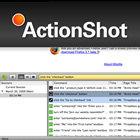
ActionShot / CoScripter Reusable History
CoScripter Reusable History records everything you do on the web and captures a log of your web browsing activity. You can review your CoScripter history to find actions that you do often, convert sequences of actions into reusable scripts, and share them with your friends.
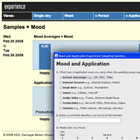
ES+Feedback
ES+Feedback extends the experience sampling method by providing feedback/visualizations of the users’ collected responses. During a one month study of the method with 25 participants, we found that participants who saw visualizations maintained the same level of participation, while those who didn’t see visualizations decreased.
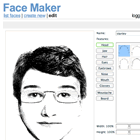
My Agent as Myself
My Agent as Myself studies what happens when users interact with embodied conversational agents that look like them. Would users follow the agents’ advice? Users in the study created faces for agents, one that resembled them and one that is suitable for providing feedback. We found when someone else created the faces, users listened more to faces that resembled them. However, when users created the faces, they listened less to their own face.
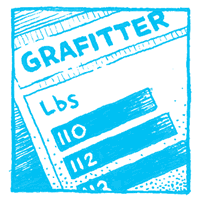
Grafitter
Grafitter facilitates collection of personal information by leveraging people’s everyday use of Twitter. Users can explore their Twitter updates for patterns and trends using Grafitter visualizations.
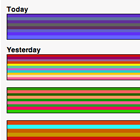
MoodJam is a website that allows users to record their moods and share them with friends and family. Users record their moods with words and color combinations, which are visualized as color strips. The site serves as a mood diary for users to reflect on trends of their moods and on colors they associate with specific moods. The site also serves as an awareness tool for users to keep in touch with friends and family.

Office Activity Awareness
Keeping track of one’s activities detracts from actual work, but awareness of activities can help in managing productivity. I created a system that tracks activities around the work table and correlated them with self-reported measurements of productivity.
Integrating Visualizations with Innertube
November 2011
Quantified Self 2011 Amsterdam
3 Design Considerations for Personal Informatics Tools
November 2011
Quantified Self 2011 Amsterdam
Understanding My Data, Myself: Supporting Self-Reflection with Ubicomp Technologies
September 2011
Ubicomp 2011, Beijing China
Thesis Defense - Personal Informatics and Context: Using Context to Reveal Factors that Affect Behavior
August 2011
Carnegie Mellon University
Challenges of Self-Tracking (or Why I Spent 7 Years Doing Research
June 2011
Quantified Self 2011, Mountain View, CA
Holistic & Human-Centered: Towards Making Better Self-Tracking Tools
June 2010
Institute for the Future Health Horizons 2010, Sausalito, CA
Personal Informatics and HCI
June 2010
Intel, Santa Clara, CA
A Stage-Based Model of Personal Informatics Systems
April 2010
CHI 2010, Atlanta, GA
Thesis Proposal - Personal Informatics and Context: Using Context to Reveal Factors that Affect Behavior
March 2010
Carnegie Mellon University